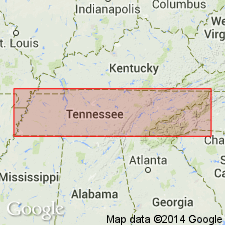
- Usage in publication:
-
- Ocoee conglomerates and slates
- Modifications:
-
- Named
- Dominant lithology:
-
- Conglomerate
- Slate
- AAPG geologic province:
-
- Appalachian basin
Summary:
Unit is exposed along narrows of the Ocoee [Polk Co., TN]. Described as a very heavy formation, many thousand ft thick. Constitutes most of mountainous parts of Polk, Monroe, Blount, Sevier, and Cocke Cos. The rocks are coarse gray conglomerates and talcose, chlorite, clay slates, all repeatedly interstratified and generally dipping at high angles to the southeast. The conglomerate abounds in quartz and feldspar pebbles; occasionally it is sandstone. The slates are generally greenish, though dark-purplish clay slates are present. Talcose and chlorite varieties mostly prevail. Assigned to Azoic. Overlie Mica Slate group and underlie Chilhowee sandstones and shales. Ocoee extends from eastern TN and western NC to northwestern GA. Assigned to Early Cambrian. [As mapped and more fully described by Safford in his 1869 report on the Geology of TN, his Ocoee group included the formations later named by A. Keith: Clingman conglomerate, Hazel slate, Thunderhead conglomerate, Cades conglomerate, Pigeon slate, Citico conglomerate, Wilhite slate, Cochran conglomerate, Hiwassee slate, Nottely quartzite, Andrews schist, Murphy marble, Valleytown formation, Brasstown schist, Tusquitee quartzite, Nantahala slate, Great Smoky conglomerate, Snowbird formation, and Unicoi formation.]
Source: GNU records (USGS DDS-6; Reston GNULEX).
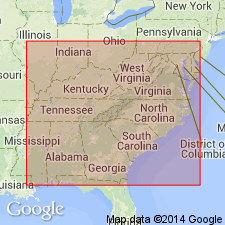
- Usage in publication:
-
- Ocoee series
- Modifications:
-
- Revised
- AAPG geologic province:
-
- Appalachian basin
- Piedmont-Blue Ridge province
Summary:
Ocoee series, as interpreted in this paper, forms a continuous belt that extends from the southwest end of Buffalo Mountain, TN, southwestward across southern TN, NC, and GA. Length of belt to AL Stale line is about 250 mi. It varies in width from 2.5 mi at northeast end to a maximum of 25 mi in area southeast of Chilhowee Mountains. Talladega series of AL is correlated with entire belt of Ocoee series as defined in this paper. Age is late Precambrian.
Source: GNU records (USGS DDS-6; Reston GNULEX).
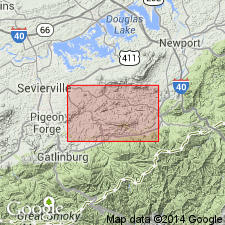
- Usage in publication:
-
- Ocoee series*
- Modifications:
-
- Revised
- AAPG geologic province:
-
- Appalachian basin
Summary:
Ocoee series includes Snowbird group and its Roaring Fork sandstone and Pigeon siltstone; unnamed rocks of Webb Mountain and Big Ridge; and Walden Creek group and it Licklog formation, Shields formation (here divided into conglomerate of Shields Mountain and slate of Richardson Cove), Wilhite formation (divided into Dixon Mountain and Yellow breeches members), and Sandsuck formation (here divided into three unnamed members). In these quads, Snowbird and Walden Creek groups are separated by major faults. Rocks of Webb Mountain and Big Ridge are probably equivalent to Rich Butt sandstone and possibly to Cades sandstone, both of Ocoee series. Age is late Precambrian. Report includes geologic map, cross sections, correlation chart, and measured sections.
Source: GNU records (USGS DDS-6; Reston GNULEX).
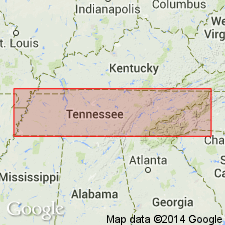
- Usage in publication:
-
- Ocoee Supergroup
- Modifications:
-
- Overview
- AAPG geologic province:
-
- Appalachian basin
Summary:
In eastern TN, Ocoee Supergroup includes three groups: 1) Snowbird Group with its Wading Branch Formation, Longarm Quartzite, Metcalf Phyllite, Roaring Fork Sandstone, and Pigeon Siltstone; 2) Great Smoky Group which, in Great Smoky Mountains contains Elkmont Sandstone, Thunderhead Sandstone, Anakeesta Formation, and an unnamed sandstone; and in Ducktown area consists of Copperhill, Hughes Gap, Hothouse, and Dean Formations, all mapped undivided; and 3) Walden Creek Group with its Licklog, Shields, Wilhite, and Sandsuck Formations. Ocoee also includes Rich Butt Sandstone and Cades Sandstone (stratigraphic positions unknown). Age of all units is Precambrian.
Source: GNU records (USGS DDS-6; Reston GNULEX).
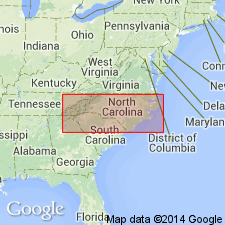
- Usage in publication:
-
- Ocoee Supergroup
- Modifications:
-
- Overview
- Revised
- AAPG geologic province:
-
- Piedmont-Blue Ridge province
Summary:
In Blue Ridge belt of western NC, Ocoee Supergroup includes the following three groups and their respective formations: 1) Snowbird Group and its Wading Branch Formation, Longarm Quartzite, Roaring Fork Sandstone, and Pigeon Siltstone; 2) Great Smoky Group and its Rich Butt Sandstone (here assigned); Boyd Gap Formation; Anakeesta Formation; unnamed phyllite; Copperhill Formation (with separately mapped unnamed slate member); Wehutty Formation; metasandstone, metagraywacke, metasiltstone, and mica schist that includes Hughes Gap and Hothouse Formations in the southern area and Horse Branch Member of Ammons Formation and Grassy Branch Formation in northern area; and Dean Formation; and 3) Walden Creek Group with its Sandsuck Formation. Age is Late Proterozoic.
Source: GNU records (USGS DDS-6; Reston GNULEX).
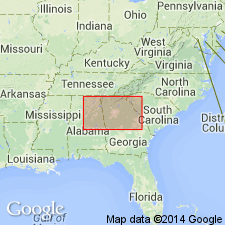
- Usage in publication:
-
- Ocoee Supergroup*
- Modifications:
-
- Revised
- Age modified
- AAPG geologic province:
-
- Piedmont-Blue Ridge province
Summary:
In the Bill Arp thrust sheet in northern GA the Ocoee Supergroup includes the following units: Great Smoky Group and its Frolona, Bill Arp, Ola, Kalves Creek, Richard Russell, Copperhill, Wehutty, Hughes Gap, Hothouse, and Dean Formations; Pine Mountain Group and its Hollis Quartzite, Manchester Schist, Mountain Creek Formation, and Chewacla Marble; and the Pinelog Formation. Age is Late Proterozoic.
Source: GNU records (USGS DDS-6; Reston GNULEX).
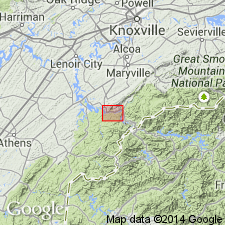
- Usage in publication:
-
- Ocoee Supergroup
- Modifications:
-
- Age modified
- Biostratigraphic dating
- AAPG geologic province:
-
- Appalachian basin
Summary:
A newly discovered fossil assemblage in the Wilhite Formation, including trilobite, ostracod, bryozoan, and microcrinoid fragments and agglutinated foraminifers prove a Silurian or younger age for the Walden Creek Group of the Ocoee Supergroup. The shale overlying the Wilhite Formation in the area south of English Mountain cannot be correlated with the Sandsuck Formation underlying the Chilhowee Group on Chilhowee Mountain and English Mountain. The name Sandsuck should not be used for this uppermost unit of the Walden Creek Group.
Source: GNU records (USGS DDS-6; Reston GNULEX).

- Usage in publication:
-
- Ocoee Supergroup
- Modifications:
-
- Overview
- Age modified
- AAPG geologic province:
-
- Piedmont-Blue Ridge province
Summary:
Discovery of shelly fossils in the Wilhite Formation by Unrug and Unrug (1990) is very important for it means that some of the Ocoee must then be Paleozoic. A Silurian age for the Wilhite, however, has not been proven. Author suggests that fossils here belong to the Tommotian stage, known for its variety of tiny shelly fossils many without descendants.
Source: GNU records (USGS DDS-6; Reston GNULEX).

- Usage in publication:
-
- Ocoee Supergroup
- Modifications:
-
- Biostratigraphic dating
- AAPG geologic province:
-
- Piedmont-Blue Ridge province
Summary:
New microfossil discoveries in the Little Tennessee River Valley indicate age of Walden Creek Group is Late Devonian to earliest Mississippian, and therefore related to the Acadian Orogeny. Fossils have been found along the entire outcrop belt of the Walden Creek Group from Hot Springs, NC, to the Ocoee River Gorge, TN. A conformable contact between the Walden Creek Group and the Great Smoky Group implies that the Great Smoky and possibly the entire Ocoee Supergroup are also Paleozoic. Great Smoky Group is here tentatively correlated with the Lay Dam Formation.
Source: GNU records (USGS DDS-6; Reston GNULEX).
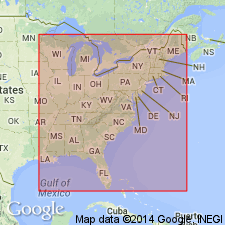
- Usage in publication:
-
- Ocoee Supergroup*
- Modifications:
-
- Areal extent
- AAPG geologic province:
-
- Piedmont-Blue Ridge province
Summary:
Hadley and Nelson (1971) mapped a large area northeast and east of Asheville, NC, as Great Smoky Group of Ocoee Supergroup. These rocks interfinger to the northeast with amphibolitic rocks in the Spruce Pine area, correlated by Rankin (1979) with Ashe Formation (as here revised to include only those rocks stratigraphically(?) below Alligator Back Formation). Rocks of the Great Smoky Group as mapped by Hadley and Nelson, 1971) and rocks of the Spruce Pine area contain lenses of ultramafic rocks. Rankin (1975) noted that southwest of Grandfather Mountain window, amphibolites and ultramafic bodies in Blue Ridge tectonic province are restricted to southeast side of hypothesized fault (later named Hayesville fault by Hatcher, 1978). Hayesville fault is now thought to be a major tectonic boundary in southern Appalachians, carrying Jefferson terrane over Laurentia. Therefore, the Ocoee Supergroup rocks should not extend southeast of (or above) Hayesville fault. Report includes geologic maps, correlation chart, and isotopic data.
Source: GNU records (USGS DDS-6; Reston GNULEX).
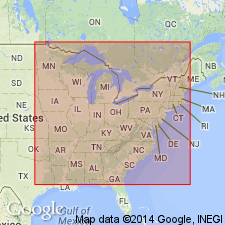
- Usage in publication:
-
- Ocoee Supergroup*
- Modifications:
-
- Overview
- AAPG geologic province:
-
- Piedmont-Blue Ridge province
Summary:
On the correlation chart for Precambrian rocks of the conterminous United States, the Ocoee Supergroup in the central and southern Laurentian Appalachians is shown as Late Proterozoic ranging from 800 to 570 Ma, although the age is uncertain.
Source: GNU records (USGS DDS-6; Reston GNULEX).
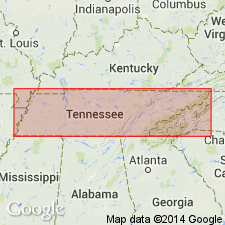
- Usage in publication:
-
- Ocoee Supergroup
- Modifications:
-
- Overview
- AAPG geologic province:
-
- Piedmont-Blue Ridge province
Summary:
The following correlations of units within the Ocoee in southeastern TN are proposed in this guidebook. Within the Great Smoky Group, the Copperhill correlates with the Elkmont, the Wehutty with the Farner and Anakeesta, the Ammons with the Boyd Gap, and the Dean with the Buck Bald. No correlation is proposed for the Grassy Branch. The Cades Sandstone is correlated with the Dean Formation. Within the overlying Walden Creek Group, the Wilhite is correlated with the Nantahala and the Sandsuck with the Brasstown. The Walden Creek has been correlated previously with the Middle Ordovician Mineral Bluff by Tull and others (1990, 1993). Through much of the area, the contact between the Great Smoky Group and the Walden Creek Group is conformable.
Source: GNU records (USGS DDS-6; Reston GNULEX).
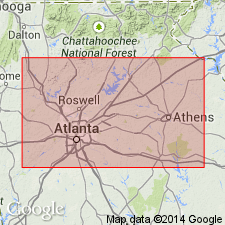
- Usage in publication:
-
- Ocoee Supergroup*
- Modifications:
-
- Revised
- AAPG geologic province:
-
- Piedmont-Blue Ridge province
Summary:
Pinelog Formation removed from Ocoee Supergroup and is tentatively correlated with Chilhowee Group. Age is now considered Late Proterozoic to Early Cambrian. Contains metaconglomerate lenses that are derived from Corbin Metagranite (revised); quartzite of Pinelog contains lenses and thin layers of graphitic phyllite identical to that in Nantahala Formation. Pinelog and Nantahala may be facies of one another. Pinelog is lithologically identical to parts of Chilhowee Group exposed on Chilhowee Mountain, TN, and is in same structural position as Chilhowee in the orogen, has same relations to same Lower Cambrian units in Rome Valley to the west, and contains worm-tube molds like those found in Chilhowee in TN. Therefore, assignment is made to Chilhowee Group. Bill Arp Formation is removed from Great Smoky Group, but little evidence exists for or against its removal from Ocoee. Frolona Formation is removed from both Great Smoky Group and from Ocoee Supergroup.
Source: GNU records (USGS DDS-6; Reston GNULEX).
For more information, please contact Nancy Stamm, Geologic Names Committee Secretary.
Asterisk (*) indicates published by U.S. Geological Survey authors.
"No current usage" (†) implies that a name has been abandoned or has fallen into disuse. Former usage and, if known, replacement name given in parentheses ( ).
Slash (/) indicates name conflicts with nomenclatural guidelines (CSN, 1933; ACSN, 1961, 1970; NACSN, 1983, 2005, 2021). May be explained within brackets ([ ]).

